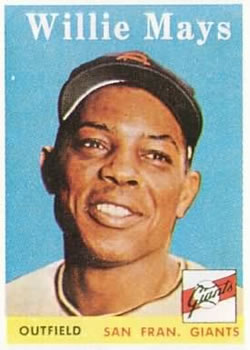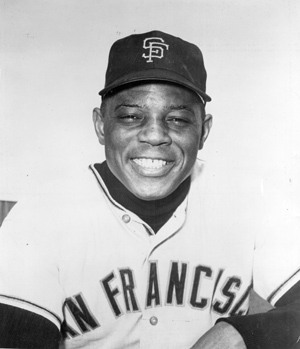April 26, 1958: Willie Mays ‘seals’ Giants’ win with first homer in San Francisco
 For Willie Mays, the April 26, 1958, game between his San Francisco Giants and the Chicago Cubs was historic, as the game saw the Say Hey Kid’s first-ever home run as a San Francisco Giant.
For Willie Mays, the April 26, 1958, game between his San Francisco Giants and the Chicago Cubs was historic, as the game saw the Say Hey Kid’s first-ever home run as a San Francisco Giant.
The Cubs arrived in San Francisco that weekend playing well, having won consecutive series against the St. Louis Cardinals and Los Angeles Dodgers. But the Giants proved a stiff challenge, defeating the Cubs 2-0 in the opener at Seals Stadium.
The next day the Cubs again challenged the Giants. The Cubs were 6-3 so far, while the Giants were slightly better at 7-3. Because they had started the season off well, both teams were undoubtedly hopeful.
In efforts to turn that hope into reality, Giants manager Bill Rigney started Johnny Antonelli, while the Cubs skipper, Bob Scheffing, went with Glen Hobbie.
As Antonelli strode to the mound, a crowd of 19,284 ambled about, ready to support their new team. That was a titanic draw in 1958, and a prime reason why Giants owner Horace Stoneham had moved the team to the West Coast. New York City was the Giants’ birthplace, and the team had played most of its home games at the glorious Polo Grounds. But attendance had dwindled, and in 1957 the Giants averaged a paltry 8,493 fans per game, second lowest in the majors.
And so the Giants left New York City and moved to San Francisco, in search of more fans, more money, and more wins. The 19,284 fans present on April 26 definitely helped bring in more fans and money, while Johnny Antonelli hoped to add more wins.
But winning ain’t easy, and for Antonelli, the game started inauspiciously. The Cubs’ first-year second baseman, Tony Taylor, smacked a single to center field. The young Cuban infielder would have a notable career and was a threat to steal bases. Having him prowl about on first base was no way for Antonelli to begin his afternoon, especially as sluggers Lee Walls and Ernie Banks were lurking.
Yet, Antonelli was able to recover and face the minimum three batters in the inning, when with one out Banks grounded into a double play to retire the side.1
With Antonelli resting on the bench, the Giants offense began in futile fashion as Cubs starter Hobbie retired the hitters in order in the bottom of the first. Hobbie, who had just made the Cubs rotation that spring training, even retired Mays, who hit a “screaming line drive” that shortstop Banks jumped “high to grab.” This was the only time Mays recorded an out in the game.2
Ernie Banks had come into Seals Stadium playing well, hitting above .300 and slugging above .600. Banks was radiantly hot throughout the 1958 season, and ultimately led the National League in slugging, home runs, runs batted in, and total bases. Such dominance helped the slugger win the Most Valuable Player Award, one he would win again the next season.
After he snagged snagging Mays’ line drive, Banks and his teammates ambled into the dugout, doubtlessly eager to resume their offensive efforts. Again, the Cubs’ leadoff man, now Walt Moryn, reached base via a hit-by-pitch. Antonelli made up for the mistake, inducing the next three Cubs to fly out, including former Giant Bobby Thomson.
During the early innings, the game generally followed this pattern. Runners would get on, but the rally was quickly squelched. Mays helped break this pattern, leading off the fourth inning with a double to right field. Left fielder Hank Sauer, a former Cub and the 1952 MVP, singled, and Mays flew around the bases, reaching home and scoring the game’s first run.
Along with power, speed was an essential and excellent part of Mays’ game. His iconic catches and baserunning relied on his speed. Mays led the league in steals every year from 1956 through 1959. Thanks to such speed, the Giants now had the lead to the delight of the Seals Stadium faithful.3
After Mays scored, the Giants were retired. The Cubs seemed about to retaliate, with their first two batters, Johnny Goryl and El Tappe, both hitting singles to start the top of the fifth inning. But again, despite allowing two baserunners, Antonelli was unfazed and retired the next three batters in order.
The Giants could not add to their lead in the bottom of the fifth, and again the Cubs wasted another runner in the top of the sixth, this time due to a double play. Mays again broke the monotony in the bottom of the sixth.
He led off again and crushed a 370-foot home run to left field. It was his first home run of the season, the first West Coast home run he ever hit, and his first home run as a San Francisco Giant. In the immediate context, the home run proved to be the winning run in the game, as the Cubs scored just once.
In 1958 Mays hit 29 home runs, tied for the fewest he hit during the stretch between his return from military service in 1954 and 1966. Despite the relatively lower home-run total, Mays still led the league in both OPS (1.002) and OPS+ (165) in 1958. He hit .347, the highest batting average of his career, and he finished second in MVP voting to Banks.
According to form, the Cubs stranded a runner in the top of seventh, unable to respond to Mays’ blast. Hobbie then left the game and was replaced by Dolan Nichols, who retired the Giants in the bottom of the seventh.
The Cubs scored their only run in the eighth. Right fielder Lee Walls smashed a 375-foot home run. It was the fifth of the young season for Walls, who hit 24 home runs in 1958, led the league in HBP (8), had a 4.4 WAR, and had a .304/.370/.493 slash line. He was an All-Star as well.
Banks stepped up the plate right after Walls and smashed a double. Antonelli was in trouble. Again, though, Antonelli ended the inning and stranded Banks. For the entire game, “Walls was the only Cub to touch third base.”4
In the Giants’ half of the eighth, Mays led off for the third time and recorded his third straight extra-base hit. But while his earlier hits were powerful, this double was no line drive but a “high fly to short right” that “Walls could not handle.”5
A reporter commented that the wind took the ball “out of the hands of Walls” and “Willie kept right on going to turn what at first appeared to be an out into a double.”6 Mays hit 33 doubles in 1958, and during his 15 seasons as a San Francisco Giant, he hit 30 or more two-baggers five times.
Mays scored another run for the Giants, this time driven in by Daryl Spencer’s two-out double. Ed Mayer relieved Nichols and recorded the final out of the inning.
Down by two runs, Chicago had only three outs left. And Antonelli retired the Cubs in order, for the first time since the fourth inning. (The fourth and ninth were the only two innings in which the Cubs had no baserunners.)
Antonelli’s ability to pitch through trouble helped him complete a “minor masterpiece,” and Emmons Byrne noted that “Lovable John, always a control pitcher, has seldom been better as his 91 pitches in nine innings indicate.”7
Yet, despite his apt performance, the postgame clubhouse scene was not a love affair for Antonelli, who had a tumultuous relationship with the San Francisco-area press. On that day he was “still having no part of the Bay Area press, and angrily ordered a cameraman, who wanted to take his picture, out of the clubhouse.”8
For his part, Antonelli excelled as a Giant until his last season in New York in 1957, when his struggles culminated in a 12-18 record. Sportswriter Byrne wrote that the “irritation” began with “printed speculation as to the condition of his arm” during these struggles. Antonelli seemed to at least concede that his grievance with the press was new, noting that “this is the first time I can’t get along with the press.”9 Sadly for Antonelli, he has often been remembered for such conflicts rather than for his pitching acumen.
As for Mays, Byrne said that the center fielder “literally ran away with the game.”10
Another reporter had similar praise, describing Mays’ performance as “a one-man show.”11
SOURCES
In addition to the sources cited in the Notes, the author consulted Baseball-Reference.com
https://www.baseball-reference.com/boxes/SFN/SFN195804260.shtml
https://www.retrosheet.org/boxesetc/1958/B04260SFN1958.htm
NOTES
1 Antonelli was talented, and certainly capable of retiring Banks and stranding runners. Like Willie Mays, Antonelli had been a star prospect, having signed a massive contract out of high school. In the majors, though, he had languished with the Boston/Milwaukee Braves until 1954 when the Giants traded Bobby Thomson and catcher Sammy Calderone for Antonelli, Don Liddle, Ebba St. Claire, Billy Klaus, and $50,000. Antonelli noted that the trade was “the best break of my career.” Alexander Edelman, “Johnny Antonelli,” SABR BioProject.
2 Alan Kline, “Mays Homers, Doubles Twice, as Giants Edge Chicago 3-1,” Santa Cruz (California) Sentinel, April 27, 1958: 14.
3 This opening of the scoring doubtless pleased the Seals Stadium crowd, who were used to their team scoring runs in their beautiful downtown stadium. As noted in Eric Enders’ Ballparks Then and Now, Seals Stadium had hosted the vaunted San Francisco Seals minor-league team for years, a squad that won 15 Pacific Coast League titles and always had good players, including the San Francisco native and legendary DiMaggio brothers, Dom, Vince, and Joe DiMaggio. Eric Enders, Ballparks Then and Now (London: Pavilion Books, 2019), 144-45. Joe DiMaggio was an idol of Mays as Joe Posnanski noted in his book, The Baseball 100 (New York: Avid Reader Press, 2021), 819.
4 Kline, “Mays Homers, Doubles Twice, as Giants Edge Chicago 3-1.”
5 Kline.
6 Emmons Byrne, “Mays Hits First Homer as Giants Beat Cubs,” Oakland Tribune, April 27, 1958: 57, 60.
7 Byrne.
8 Byrne.
9 Byrne.
10 Byrne.
11 Kline.
Additional Stats
San Francisco Giants 3
Chicago Cubs 1
Seals Stadium
San Francisco, CA
Box Score + PBP:
Corrections? Additions?
If you can help us improve this game story, contact us.


